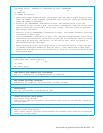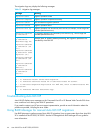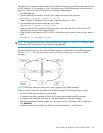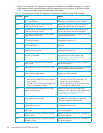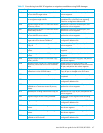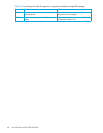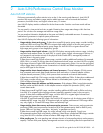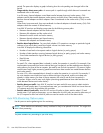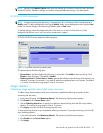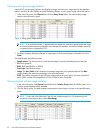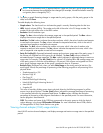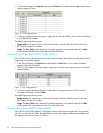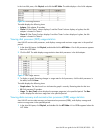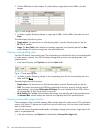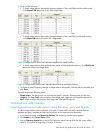
50 Auto LUN/Performance Control Base Monitor
period. The pane also displays a graph indicating how the write pending rate changed within that
period.
• Usage statistics about access paths. An access path is a path through which data and commands are
transferred within a disk array.
In a disk array, channel adapters control data transfer between hosts and cache memory. Disk
adapters control data transfer between cache memory and disk drives. Data transfer does not occur
between channel adapters and disk adapters. Data is transferred via the cache switch (CSW) to cache
memory.
When hosts issue commands, they are transferred via channel adapters to shared memory (SM). Disk
adapters check the contents of shared memory.
Auto LUN XP monitors and displays usage rates for the following access paths:
• Between channel adapters and the cache switch
• Between disk adapters and the cache switch
• Between the cache switch and cache memory
• Between channel adapters and shared memory
• Between disk adapters and shared memory
• Statistics about logical devices. You can check whether I/O operations converge on particular logical
volumes or how much data is read from logical volumes into cache memory.
Auto LUN XP displays the following information:
• Number of read and write requests made to logical devices (or parity groups)
• Number of data transfers occurring between logical devices (or parity groups) and cache memory
• Size of data transferred to logical devices (or parity groups)
• Read hit rate
• Write hit rate
For read I/Os, when requested data is already in cache, the operation is a read hit. For example, if ten
read requests were made from hosts to devices during a time period, and the read data was already in
cache memory for three of the ten requests, the read hit rate for that time period is 30 percent. Higher
read hit rates imply higher processing speed because fewer data transfers are made between devices
and cache memory.
For write I/Os, when requested data is already in cache, the operation is a write hit. For example, if
ten write requests were made from hosts to devices during a time period, and the write data was
already in cache memory for three of the ten requests, the write hit rate for that time period is
30 percent. Higher write hit rates imply higher processing speed because fewer data transfers are
made between devices and cache memory.
• Statistics about port traffic. Auto LUN XP monitors host ports and disk array ports to obtain statistics
about I/O and transfer rates. If you analyze these rates, you can determine which host issues the most
I/O requests and which host transfers the most data.
• Statistics about LU path traffic. Auto LUN XP monitors LU paths to obtain statistics about I/O and
transfer rates. If you analyze these rates, you can determine which LU paths are used to make many of
the I/O requests to disks and which LU paths are used to transfer much of the data to disks.
Auto LUN Monitoring Options pane
Use this pane to set the gathering time for monitoring.
NOTE: When statistics are collected, a heavy workload is likely to be placed on servers. This might slow
down client processing.
The pane contents vary according to your disk array.




